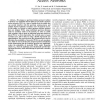240 search results - page 11 / 48 » Malicious Users in Unstructured Networks |
GCC
2005
Springer
14 years 1 months ago
2005
Springer
Peer-to-peer networks can be divided into structured and unstructured based on their overlay topologies. In reality, unstructured p2p networks with superpeers have proved their cap...
SEMWEB
2004
Springer
14 years 24 days ago
2004
Springer
P2P networks have become increasingly popular in the recent years. However, their open, distributed and anonymous nature makes them very vulnerable against malicious users who prov...
NCA
2005
IEEE
14 years 1 months ago
2005
IEEE
In distributed P2P environments, peers (i.e., users) often have to request the services from some unfamiliar peers (i.e., resources) that could be altruistic, selfish, or even ma...
GLOBECOM
2010
IEEE
13 years 5 months ago
2010
IEEE
We propose a spectrum decision protocol resilient to primary user emulation attacks (PUEA) in dynamic spectrum access networks. PUEA is a type of denial-of-service attack that can ...
ACSAC
2010
IEEE
12 years 11 months ago
2010
IEEE
In this work we show that once a single peer-to-peer (P2P) bot is detected in a network, it may be possible to efficiently identify other members of the same botnet in the same ne...

